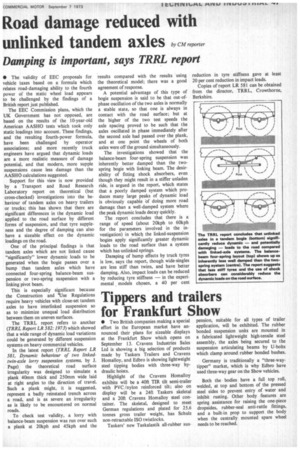Road damage reduced with
Page 49

If you've noticed an error in this article please click here to report it so we can fix it.
unlinked tandem axles by CM reporter
Damping is important, says TRRL report
• The validity of EEC proposals for vehicle taxes based on a formula which relates road-damaging ability to the fourth power of the static wheel load appears to be challenged by the findings of a British report just published.
The EEC Commission plans. which the UK Government has not opposed, are based on the results of the 10-year-old American AASHO tests which took only static loadings into account. These findings, and the resulting fourth-power formula, have been challenged by operator associations: and more recently truck engineers have argued that dynamic loads are a more realistic measure of damage potential. and that modern, more supple suspensions cause less damage than the AASHO calculations suggested.
Support for this view is now provided by a Transport and Road Research Laboratory report on theoretical (but cross-checked) investigations into the behaviour of tandem axles on heavy trailers or trucks: this has shown that there are significant differences in the dynamic load applied to the road surface by different forms of suspension, and that tyre suppleness and the degree of damping can also have a sizeable effect on the dynamic loadings on the road.
One of the principal findings is that tandem axles which are not linked cause "significantly" lower dynamic loads to be generated when the bogie passes over a bump than tandem axles which have connected four-spring balance-beam suspension or two-spring suspension with a linking pivot beam.
This is especially significant because the Construction and use Regulations require heavy vehicles with close-set tandem axles to have interlinked suspension so as to minimize unequal load distribution between them on uneven surfaces.
The TRRL report refers to another (TRRL Report LR 582: 1973) which showed that a wide range of dynamic load variations could be generated by different suspension systems on heavy commercial vehicles.
In the latest report (TRRL Report LR 581, Dynamic behaviour of two linkedtwin-axle lorry suspension systems, by J. Page) the theoretical road surface irregularity was designed to simulate a plank 40mm thick and 250mm wide laid at right angles to the direction of travel. Such a plank might. it is suggested, represent a badly reinstated trench across a road, and is as severe an irregularity as is likely to be encountered on normal roads.
To check test validity, a lorry with balance beam suspension was run over such a plank at 20kph and 45kph and the results compared with the results using the theoretical model; there was a good agreement of response.
A potential advantage of this type of bogie suspension is said to be that out-ofphase oscillation of the two axles is normally a stable state, so that one is always in contact with the road surface; but at the higher of the two test speeds the axle spacing proved to be such that the axles oscillated in phase immediately after the second axle had passed over the plank, and at one point the wheels of both axles were off the ground simultaneously.
The investigations showed that the balance-beam four-spring suspension was inherently better damped than the twospring bogie with linking beam. The desirability of fitting shock absorbers, even though they might result in a stiffer unladen ride, is argued in the report, which states that a poorly damped system which produces many large peaks of dynamic load is obviously capable of doing more road damage than a well-damped system where the peak dynamic loads decay quickly.
The report concludes that there is a range of speed (about 20kph to 60kph for the parameters involved in the investigation) in which the linked-suspension bogies apply significantly greater dynamic loads to the road surface than a system which has unlinked springs.
Damping of bump effects by truck tyres is low, says the report, though wide-singles are less stiff than twins, and have better damping. Also, impact loads can be reduced by reducing tyre stiffness — in the experimental models chosen, a 40 per cent








































































































































